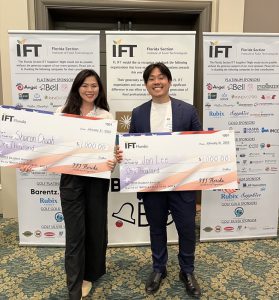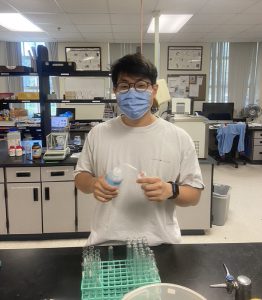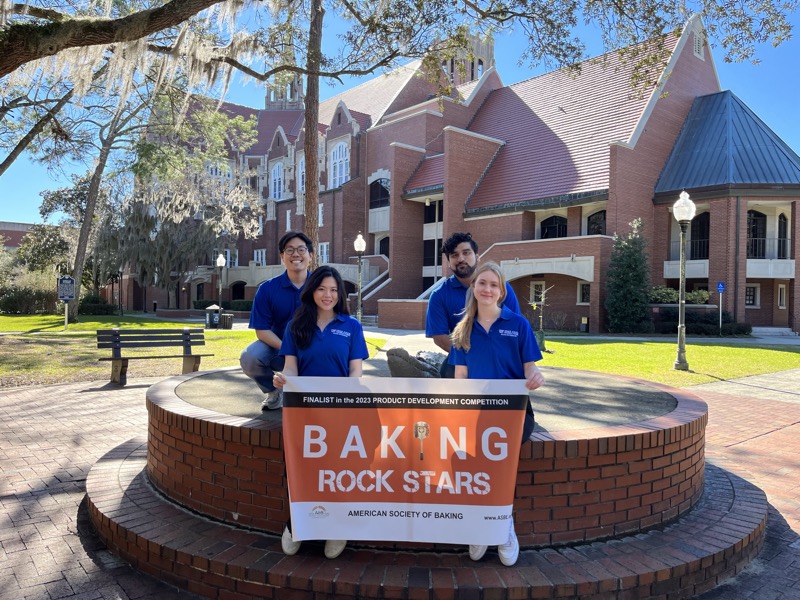 Please join me as we welcome Jon Lee to FSHN Research Journeys, which follows the research of graduate students in the Food Science and Human Nutrition program at The University of Florida. Jon is a first-year graduate student working toward his M.S. in food science under the guidance of Dr. Razieh Farzad and Dr. Andrew MacIntosh. In his research project, Jon works to solve two global problems with one elegant solution: using spent brewer’s yeast to help meet growing protein demands through aquaculture.
Please join me as we welcome Jon Lee to FSHN Research Journeys, which follows the research of graduate students in the Food Science and Human Nutrition program at The University of Florida. Jon is a first-year graduate student working toward his M.S. in food science under the guidance of Dr. Razieh Farzad and Dr. Andrew MacIntosh. In his research project, Jon works to solve two global problems with one elegant solution: using spent brewer’s yeast to help meet growing protein demands through aquaculture.
In this article, learn about his research project as well as his personal commitment to achieving a sustainable future.
Jon: Of the many joys and comforts in the world, there are few that may hold a light to one of humankind’s treasures: beer! This endearment still holds true today as nearly two billion hectoliters of beer were brewed this past year.1 To give some context, that’s over 13 six-packs for every single living human on Earth.
However, for every person’s 13 six-packs, 13 additional six-packs of waste were also produced and likely dumped. With nearly eight billion people living worldwide, that’s a lot of waste. Several initiatives are in place for reducing waste yet continuing to identify avenues of waste use is important for overall sustainability. For this project, we look to use beer waste as … fish food?

Fish and Brewer’s Yeast: A Tale of Two Species
The global demand for protein is expected to double by the year 2050.2,3 Generally, most of the traditional farmed livestock we consume are herbivores that rely on vegetative energy like grass or hay. For seafood, however, it’s a fish-eat-fish world!
Aquaculture species rely on diets with plenty of protein and omega-3 fatty acids to sustain their growth. These nutrients are traditionally provided in aquaculture by blending wild-caught fish into fish meal. However, reliance on fish meal places major pressures on wild fish populations to fuel aquaculture growth, consequently increasing fishing, transportation, and processing costs. As the aquaculture sector grows to meet protein demands, pressure on wild populations will increase, threatening environmental impacts like ecosystem imbalances and species extinction. Reducing fish meal requirements will inherently reduce these pressures.
A potential solution for reducing fish meal reliance may be found in the beer industry. Spent brewer’s yeast (SBY) is the general term for leftover accumulated yeast (generally Saccharomyces cerevisiae) from beer fermentations. Although breweries may continue using leftover yeast for new batches of beer, only around 10% of the leftover yeast is used while the rest is discarded. Each year, an estimated 309,400 to 418,600 metric tons of SBY is wasted.4

Why Spent Brewer’s Yeast is Both Harmful and Helpful
Along with being a massive source of waste, SBY can also have a detrimental impact on the environment. Live yeast has a high oxygen demand and can uptake most oxygen in an ecosystem. The live yeast in SBY can be thermally or enzymatically deactivated but requires special equipment, incurring additional capital, overhead, and maintenance costs. Even though larger, multinational breweries possess the finances to achieve cost-efficient waste processing, smaller craft breweries lack the resources to support these practices and often resort to illegal dumping.5
Here’s the great thing about yeast though: it’s an excellent protein source. Previous studies have investigated using SBY in land-grazing animal feeds,6-9 but only a few studies have examined aquaculture species.10-12 Connecting the two industries together will yield economic and environmental benefits. My research project aims to show the benefits of SBY when used as an alternative protein source in fish feeding trials.
From Eating Fish to Feeding Fish
As a kid, I always wanted to eat delicious food. This interest grew to always wanting to work with food. As an adult, I want to build a better future for generations to come. Tying in your personal mission with your personal interests is often a dream. Luckily, food science is an excellent field in which I can pursue my personal mission and interests. The University of Florida promotes a mission and values that align closely with mine, leading me to seek admission to the FSHN graduate program.
As a graduate student, I focus on pursuing research that provides a sustainable benefit. Innovating solutions that benefit both industry and the environment is a huge challenge, and I believe highlighting potential benefits in otherwise wasted materials is one of these solutions. In a capitalistic society, exercising sustainable measures without impacting economic growth is challenging. Providing sustainable solutions with economic benefits can motivate industries to transform their processes for a sustainable future.

How to Train Your Fish (to Eat Brewing Waste)
SBY is not the only potential alternative protein proposed for fish feed. Different fish meal alternatives such as micro-13 and/or macro-algae14 have been reported as feasible solutions to alleviate protein needs. However, mass-producing algae requires immense plots of land and bodies of water for meaningful growth. These requirements limit the scalability of algae production and demand high capital investment. Integrating unprocessed or minimally-processed brewery waste as an ingredient to supplement fish feed will provide a highly-scalable, low-cost protein alternative.
Establishing different avenues for waste utilization will be critical for building a more sustainable world.
My experiments will investigate the use of SBY on the growth of Nile tilapia. Nile tilapia is a prominent aquaculture species used extensively in feed studies due to their economic prevalence and hardiness/ease-of-growth. We will rear juvenile tilapia in flow-through tanks in groups of twelve to fifteen. Each set of fish will receive different diet treatments with varying amounts of spent brewer’s yeast.
Throughout the trial, I will measure the fish’s feed conversion ratio (final fish mass / total feed mass), digestibility, viscera size, and more. These metrics will help determine the relationship between protein replacement and fish production while highlighting the optimal dosage acceptable for fish growth. Overall, I hope the results of my research may transform the aquaculture and brewing industries and inspire future initiatives involving the valorization of waste streams.

Swimming (and Drinking) to the Future
Despite the straightforward nature of my experiments, I may run into challenges as I carry out my project. For example, building consistency with any set of live organisms is a major challenge. Many interrelated factors with yeast conditions can affect targeted results in growth studies. Some of these factors can include yeast composition or yeast viability, both of which can affect processing procedures and eventually affect fish growth. Other factors that may influence fish growth are difficult to predict. Feed studies require a high degree of physical work including fish feed extrusion, yeast propagation, and fish feeding.
Through it all, beer will continue to be one of mankind’s treasures. Global population gains will continue to drive demand for beer and consequently produce more waste. Establishing different avenues for waste utilization will be critical for building a more sustainable world. Turning SBY into a supplemental protein in fish feed will support aquaculture sector growth while providing much-needed relief to our oceanic populations.
Project note: This project is funded through the Lee C. Yeoman’s Fisheries and Aquatic Sciences Fellowship Fund.
Jon Lee is a food science graduate student at the University of Florida’s Food Science and Human Nutrition Department expecting to graduate with his master’s degree by August 2024. His thesis involves the investigation of spent brewer’s yeast as a feed supplement to fish meal in fish feed. He is also the treasurer of the Food Science and Technology Graduate Student Association, a member of UF’s ABSE Product development team, and the father of two cuddly cats. After graduation, he hopes to work in a role focused on culinary product development. He enjoys cooking, home projects, and Sunday morning pickleball.
References
- BarthHaas. BarthHaas Report. 2022.
- Henchion M, Hayes M, Mullen AM, Fenelon M, Tiwari B. Future Protein Supply and Demand: Strategies and Factors Influencing a Sustainable Equilibrium. Foods. Jul 20 2017;6(7)
- RaboResearch. Global Animal Protein Outlook 2022. 2022.
- Oliveira AS, Ferreira C, Pereira JO, Pintado ME, Carvalho AP. Valorisation of protein-rich extracts from spent brewer’s yeast (Saccharomyces cerevisiae): an overview. Biomass Conversion and Biorefinery. 2022/04/21 2022;doi:10.1007/s13399-022-02636-5
- Kerby C, Vriesekoop F. An Overview of the Utilisation of Brewery By-Products as Generated by British Craft Breweries. Beverages. 06/12 2017;3:24. doi:10.3390/beverages3020024
- Grieve DG. Feed Intake and Growth of Cattle Fed Liquid Brewer’s Yeast. Canadian Journal of Animal Science. 1979;59(1):89-94. doi:10.4141/cjas79-011
- Newbold C. Probiotics for ruminants. Ann Zootech. 1996;45(Suppl. 1):329-335.
- Gilchrist MJ, Greko C, Wallinga DB, Beran GW, Riley DG, Thorne PS. The Potential Role of Concentrated Animal Feeding Operations in Infectious Disease Epidemics and Antibiotic Resistance. Environmental Health Perspectives. 2007;115(2):313-316. doi:doi:10.1289/ehp.8837
- Crawshaw R. Co-product feeds: animal feeds from the food and drinks industries R Crawshaw Nottingham University Press, Nottingham, 2001 pp 285, price£ 30.00 (paperback) ISBN 1-897676-35-2. Journal of the Science of Food and Agriculture. 2003;83(4):362-362.
- Nguyen NHY, Chau DT, Lundh T, Trinh LT, Kiessling A. Comparative evaluation of Brewer’s yeast as a replacement for fishmeal in diets for tilapia (Oreochromis niloticus), reared in clear water or biofloc environments. Aquaculture. 2018/10/01/ 2018;495:654-660. doi:https://doi.org/10.1016/j.aquaculture.2018.06.035
- Nazzaro J, San Martin D, Perez-Vendrell AM, et al. Apparent digestibility coefficients of brewer’s by-products used in feeds for rainbow trout (Oncorhynchus mykiss) and gilthead seabream (Sparus aurata). Aquaculture. 08/01 2020;530:735796. doi:10.1016/j.aquaculture.2020.735796
- Konstantinidis I, Firmino JP, Ruiz A, et al. Brewer’s Spent Dry Yeast Modulates Immunity in Gilthead Sea Bream (Sparus aurata). Original Research. Frontiers in Marine Science. 2022-April-07 2022;9doi:10.3389/fmars.2022.857592
- Nagappan S, Das P, AbdulQuadir M, et al. Potential of microalgae as a sustainable feed ingredient for aquaculture. Journal of Biotechnology. 2021/11/20/ 2021;341:1-20. doi:https://doi.org/10.1016/j.jbiotec.2021.09.003
- Wan AHL, Davies SJ, Soler-Vila A, Fitzgerald R, Johnson MP. Macroalgae as a sustainable aquafeed ingredient. Reviews in Aquaculture. Aug 2019;11(3):458-492. doi:10.1111/raq.12241
Looking for more posts exploring graduate research projects in the FSHN Department at the University of Florida?
Dive into the Research Journeys of other graduate students below.
M.S. Food Science
M.S. Nutritional Sciences
Ph.D. Food Science
Ph.D. Nutritional Sciences
 1
1
